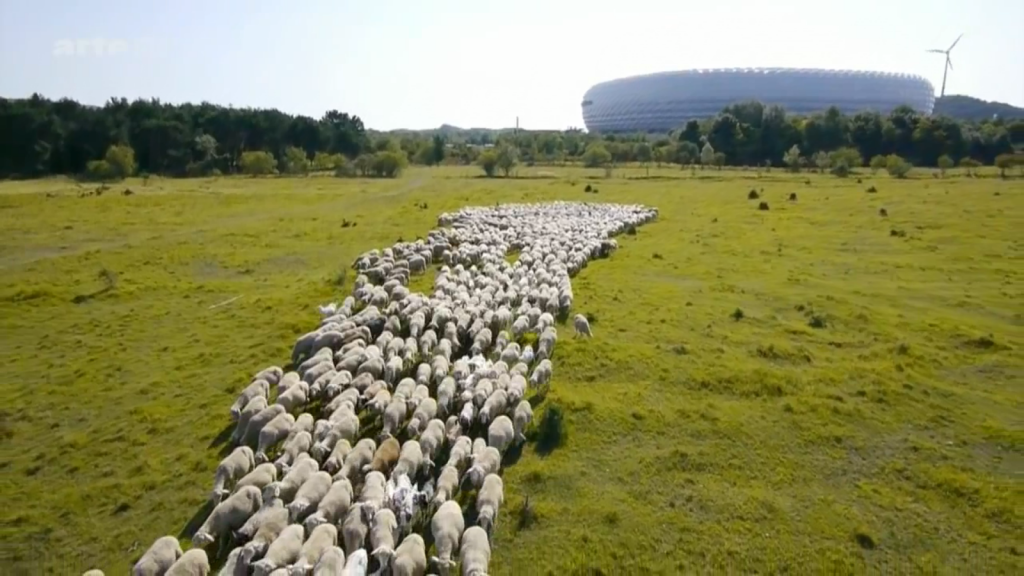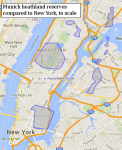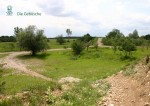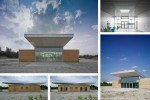Rare heathland habitats thirty minutes from city center
Recently I saw in a documentary these sheep next to the high-tech Herzog & de Meuron starchitect stadium in Munich (about twice the size of New York’s Citi Field) and had to find out what was going on. It turns out the area is a nature preserve consisting of rare chalk heathland remnants and it is indeed adjacent to the stadium. Nothing in English has been written about the site, to my knowledge.
This type of heathland was once more common in Europe, although never greatly widespread. I’m not sure whether it’s a good thing or bad thing that the stadium is right alongside. On the one hand it’s great to protect nature so close to busy places. On the other, since they were building on a site where there wasn’t a stadium previously, you’d think they could have found someplace less environmentally significant.
The site, the Fröttmaninger Heath, is one of a handful of similar small patches in a mosaic of villages, outer suburbs, small farms and former artillery ranges traversed by highways on the city’s northern fringe. The North Munich Heathlands Association, a partnership of local towns, protects the heath remnants by means of an exhaustive ecological planning, research, and restoration program along with recreation management and a supermodern visitors center. And yet the combined area of the eight sites is than that of JFK airport. It’s a remarkable intensity of activity for such a small reserve, which is funded by municipalities and the state of Bavaria, in which Munich lies, rather than relying on donations. All this certainly falls in line with Bavaria’s reputation for being one of the most richest and most pro-environment parts of Germany (both of which traits, incidentally, place it in stark contrast to Berlin, which – unbeknownst to non-Germans – has the weakest economy of any large/medium German city; in fact it is the only capital city in Europe to have a net negative impact on the country’s GDP. In terms of environmental protection, Berlin is at the German average, at best.)
Nature in Europe is interesting because their conservation works completely differently from that in the U.S.. They have no choice because Europe ran out of wilderness a thousand years ago. Despite all the deforestation going on in the U.S., it still has much, much more wild and semi-wild forest than Europe, both proportionally and in absolute terms. Germany, for example, has only a handful of tiny fragments of the kind of semi-wild, species-rich forest (“successional” in ecology jargon, roughly 70 to 150 years old) found in just about any average American state park. My rough estimate is that 90% of Americans live within 30 minutes of this kind of semi-wild publicly-accessible forest while at most 5% of Germans do. As for true old-growth forest (more than 150 or 200 years old), there is even less of it. In all of Europe there is only one substantial old-growth forest reserve, in Poland, and even that is now in mortal peril due to their far-right government.
Yet the continent has biodiversity. It arose from mosaics of traditional land uses such as farming, grazing, and forest product gathering, which enhance biodiversity by creating a variety of habitats ranging from open meadows to dense woods, as opposed to a more homogenous expanse of mature forest. However, these mosaics have largely disappeared in Germany due to industrial monocrop agriculture, which is why organizations struggle to preserve whatever landscape diversity they can.
Their word for all this is “cultural landscapes”, a term that only recently started appearing in the field of ecology in the U.S. but common in Europe. In practice this typically means encouraging farmers to modestly modify their practices – mowing, harvesting, plowing, etc. – to encourage landscape diversity and thus species and ecosystem diversity. Or, where pastures have been abandoned and would revert to forest if left untouched, conducting measures such as mowing to mimic the impact of grazing and hence maintain the pasture habitat, which has its own unique species.
The Munich heathlands contained not only rangeland for livestock but also tanning forests (Lohwald). Here, stripping bark for leather tanning had the effect of promoting a distinct forest structure and species composition, namely, forest with dense thickets of young trees that never reached the stage of tall mature trees shading an open understory. Restoration efforts address the loss of both of these human-created drivers of biodiversity as well as the impacts of heavy recreational use.



